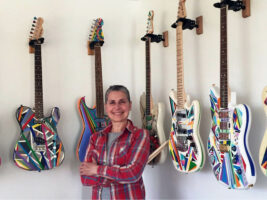
“I can make someone’s dream guitar come to life”: Julie Rosenberg on combining her love for music with her talent as a painter
You’re heavily inspired by Kandinsky’s abstract works. How did that influence develop and how does it connect to music?
“I was exposed to the work of Kandinsky (and others) while growing up. I immediately connected with the forms and especially the colors he portrayed in his compositions. I was very stimulated by the abstract scenes he set into motion. Kandinsky’s artwork reflected a galaxy of choreographed images, like a dance and a symphony, in painted shapes and lines. It was very remarkable how he achieved that. Some of his pieces look like music staves, notes and instruments, themselves. But their brightness and contrast, their subliminal lyric and flow, suggested what sound looked and felt like. Also, he was an original and a mathematician. I was attracted to his freshness and his originality that I’d like to think is in my work.”
READ MORE: A brief history of Marshall amps
What first drew you to using guitars as the focal point of your practice?
“I’m a painter and a musician. I had a vision and decided that I would paint a guitar body for myself. I went to my local guitar store and asked if they had any guitar bodies. When I arrived to see what they had found, I was handed an off-white guitar body headed for the dumpster. My eyes lit up in anticipation and excitement. And just like that I had found my ‘buried treasure.’ At home, I had all of the paints. So, I began and the design just flowed. A cabinet maker friend sprayed the clear coat finish in her shop. Years later, in the 2000s, I had one of my bodies built by a local Luthier into what would become my very first-hand painted, Strat-style guitar. That one is not for sale, but others like it are on my website.”
You’re also a musician as you mentioned, formerly studying jazz guitar. How does that influence your approach to building and painting guitars?
“Formal studies in guitar stifled me. Informally, jamming with friends feels authentic.
I think that my freest moments as a musician are when I play alongside other musicians, when we improvise together. Just like in every art form the qualities of discipline and restraint have a role. I respect that and have discovered the freedom in between those boundaries.”
When did you first realise you had a viable business?
“The overwhelming positive response on social media convinced me that other people like my work. People want one of my guitars. My peers have also expressed accolades for my work. Of course, the sales I have made really convinced me that I have a viable business.”
Did you have any external investment starting out?
“No. It was blood, sweat and tears. And my money! Like any new business I needed certain supplies. I purchased paint, brushes, necks, bodies, and parts and on the advice of luthiers and other professional guitar builders I sat down with and the creating began. I found all disparate items that served as tools to accomplish the desired effects in my work.”
All instruments are assembled by you. Do you offer customisation when it comes to the parts, such as pickups and wood choices?
“My designs are all one-of-a-kind. When someone specifically admires and requests a guitar of mine that is in my inventory or has been sold, I will create a guitar that is similar. I do offer an array of options you’d expect to see in a custom ordered guitar. Parts like bridges and tuners, knobs, necks and pickups can all be ordered according to someone’s specifications. From switches to pots, special requests in the usual hardware can be installed if it is out there and I deem it compatible with the design of the instrument. I buy pre-cut necks and bodies from industry sellers.”
“A neck can be as customized right down to the wood choice, size and material of the fret wire and the colors and style of an inlay. If my suppliers can make it, I can do it. Body shapes are not fully customizable. Yet, I can still offer a variety of styles, but they will be ones pre-fabricated, in stock by my suppliers. There is a large selection of pickups and other accoutrements that are available to me, manufactured or custom-made by the handful of luthiers I work with. After I finish my painting and selection of components, I hand it over to the luthiers I have selected to then complete the final product. As you can see, I can make someone’s dream guitar come to life.”
Given the freeform nature of your work, do you have a best-selling product?
“I have favourites, but different people like different designs. That’s what makes the world go round, and what’s interesting for me to see is how people gravitate to one design over another. There are those that only want a Strat-style and others who want a Tele-style guitar. That is why my inventory is diverse. I have some guitars that have been sold that were then sought after. I explain that I will come close, but it will not be exact. I need that freedom.”
What’s next for Julie Rosenberg Custom Guitars?
“The sky is the limit! I won’t know until I’m struck with the obsession. My visual artist/musician self would certainly be happy to see and hear on stage H.E.R. and Lenny Kravitz playing my guitars at next year’s Grammy’s, and Keith Urban at next year’s Country Music Awards… and an entire rock band all playing different guitars that I have created.”
Visit julierosenberg.com for more.
The post “I can make someone’s dream guitar come to life”: Julie Rosenberg on combining her love for music with her talent as a painter appeared first on Guitar.com | All Things Guitar.
Source: www.guitar-bass.net












